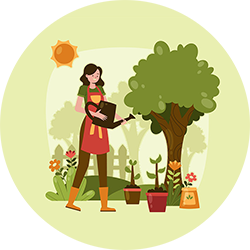How to Garden in an Apartment Without any Outdoor Space

Living in an apartment without outdoor space doesn’t mean you have to miss out on the joys of gardening. With a little creativity and the right setup, you can grow herbs, veggies, and houseplants right inside your home. This guide will show you how to make the most of your space and keep your indoor garden thriving year-round.
Related: Practical Ideas for Growing Vegetables When Space is Limited
Make the most of your light sources
One of the most important factors in apartment gardening is understanding the light you have. South-facing windows provide the most consistent sun throughout the day, while east-facing windows offer gentle morning light that’s ideal for many houseplants. If your windows are limited, using mirrors or reflective surfaces can help bounce light around your space to reach more plants.
Take a few days to observe how the light moves through your apartment. You may find that different corners get more sun than expected at certain times. Knowing where and when light appears gives you a better chance of placing the right plants in the right spots.
Invest in good grow lights
If natural light is scarce, grow lights can make a big difference. LED grow lights are energy efficient, affordable, and come in full-spectrum options that mimic natural sunlight. Fluorescent bulbs are another option, especially for seedlings or leafy greens.
Look for grow lights labeled as “full spectrum” to ensure your plants get what they need for both growth and flowering. You can mount them under shelves, hang them above a table, or attach them to adjustable arms. Timers can help automate light exposure so your plants get consistent care without much effort.
Choose plants that thrive indoors
Not all plants are suited for life indoors, so it’s best to start with varieties known for their tolerance of indoor conditions. Pothos, snake plants, ZZ plants, and philodendrons are all hardy options that do well even in lower light. For herbs, try basil, chives, parsley, or mint, especially if you have a sunny kitchen windowsill or grow light.
If you want to grow food, leafy greens like lettuce and arugula are compact and quick to harvest. Microgreens are another great option for small spaces and can grow in trays on a windowsill. With the right conditions, even compact cherry tomatoes or dwarf peppers can produce fruit indoors.
Create vertical and hanging gardens
When floor space is limited, vertical solutions are key. Wall-mounted planters and stackable shelving units can turn a bare wall into a thriving green corner. Hanging baskets are perfect for trailing plants like spider plants or string of hearts.
You can also use curtain rods, shower tension rods, or even magnetic strips to hang planters near windows. Tower gardens and compact stacking systems are especially helpful for growing herbs or greens indoors. These vertical solutions keep your plants within reach without cluttering up your living space.
Use windowsills and countertops wisely
Windowsills can be turned into mini-gardens with just a few well-placed pots. Herbs, succulents, and small flowering plants thrive in these sunny spots. Be sure to use saucers or trays to protect your window ledge from water and soil.
Countertops near windows, especially in the kitchen or bathroom, also make great growing zones. These areas often have enough warmth and moisture for herbs or tropical plants. Rotate your plants occasionally so each side gets even light exposure, especially if they start leaning toward the window.
Try hydroponics or water propagation
If you’re short on space or want to skip soil altogether, hydroponics can be a great indoor option. Countertop hydroponic kits make it easy to grow herbs and greens with little mess. Some systems even come with built-in lights, making them ideal for apartments.
For something even simpler, try propagating cuttings in water. Pothos, mint, coleus, and tradescantia all root easily in jars or vases. These displays look attractive and give you more plants without needing a lot of extra space.
Smart container choices for limited space
When space is at a premium, container selection matters. Use pots that are sized just right for your plants so they don’t waste soil or water. Self-watering containers can help reduce maintenance, especially for thirsty herbs or vegetables.
Fabric grow bags are lightweight and easy to store when not in use. Repurposed containers like mugs, jars, and food tins also make creative planters if they have drainage holes. Just be sure to add a saucer or tray underneath to catch any excess moisture.
Manage watering and humidity indoors
Watering is one of the biggest challenges in indoor gardening. Without outdoor drainage, it’s easy to overwater and damage your plants or furniture. Use pots with drainage holes, and always check the top inch of soil before adding more water.
Grouping plants together can help create a mini microclimate, boosting humidity naturally. You can also place a shallow dish of water near your plants or use a small humidifier if your apartment air is particularly dry. A simple moisture meter is a great tool to take the guesswork out of watering.
Keep your indoor garden organized
A well-organized indoor garden is easier to manage and more enjoyable to live with. Use trays, rolling carts, or shelves to create defined plant zones. This helps keep everything tidy and reduces mess from soil and water.
Label your plants so you remember what’s growing and when it needs attention. A small notebook or app can help track watering, feeding, or repotting dates. As your indoor garden grows, having a system in place makes it easier to care for each plant confidently.
Conclusion
Apartment gardening proves that you don’t need a backyard to grow something beautiful. Whether you’re growing herbs in your kitchen or starting a vertical garden by a window, small spaces can yield big rewards. Start with a few easy-care plants, adapt your space, and enjoy the greenery right where you live.
